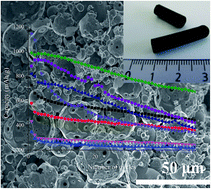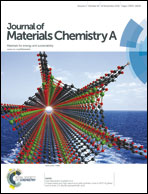Novel Au/Pd@carbon macrocellular foams as electrodes for lithium–sulfur batteries†
Abstract
Macro-mesocellular carbonaceous foams bearing metallic (Pd or Au) nanoparticles were synthesized and used to confine polysulfides at the cathode of lithium–sulfur (Li–S) batteries. We show that noble metal nanoparticles are useful for tuning the properties of cathode materials. On one hand, the surface chemistry of the metals enhances the polysulfide anchoring strength involved in carbon-based Li–S electrode cycling batteries. On the other hand, the metallic nanoparticles' nucleation and growth decreases the carbonaceous foam's mesoporosity appearing, at first glance, as a penalty. The Au@C-HIPE(80HF) sample shows a capacity for the first discharge at 327 mA h cm−3 decreasing to 182 mA h cm−3 after 50 cycles, corresponding, respectively, to 430 and 240 mA h g−1. The most efficient sample in terms of power density per mass, C-HIPE(2P5HF), exhibits a capacity for the first discharge at 202 mA h cm−3 decreasing to 150 mA h cm−3 after 50 cycles (respectively 1680 and 1000 mA h g−1). Hence, considering the capacity retention, the most interesting sample (C-HIPE(2P5HF)), if power density per weight is taken as the main criteria of choice, becomes one of the least efficient if we consider power density per volume. This work further demonstrates the importance of normalizing the power density not only by weight (mA h g−1) but also by volume (mA h cm−3) in order to provide absolute and comparable energy storage capabilities from one sample to another.


 Please wait while we load your content...
Please wait while we load your content...